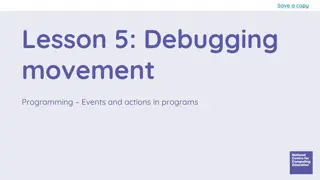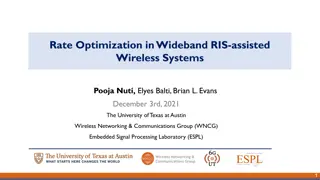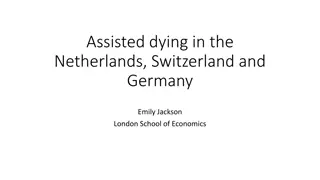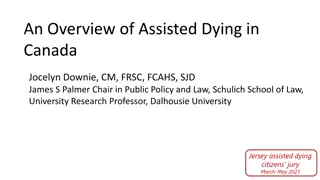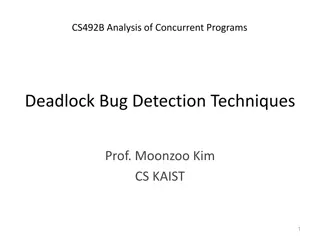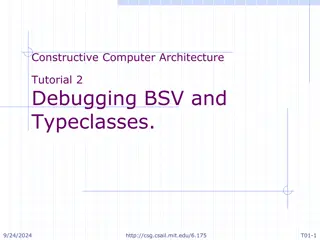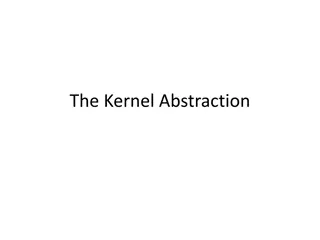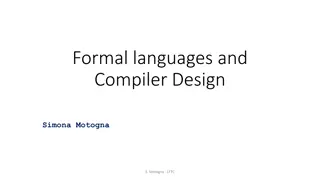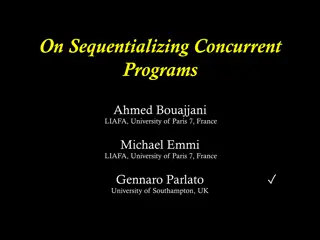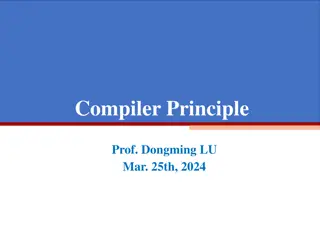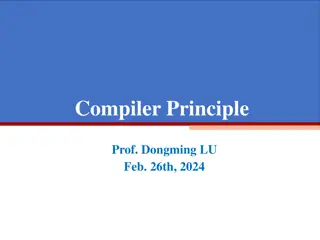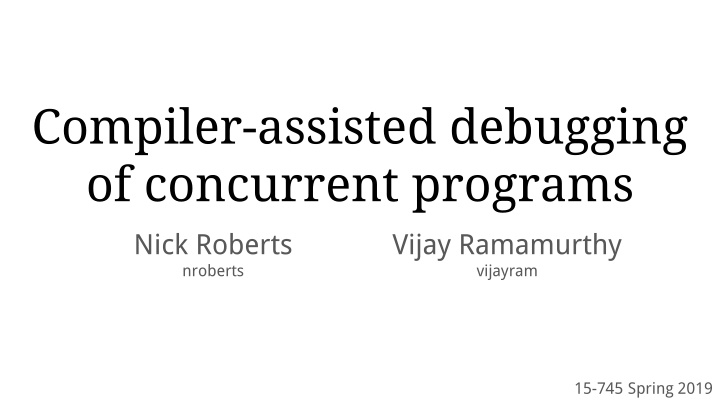
Compiler-assisted Debugging of Concurrent Programs
Techniques from optimizing compilers help identify bugs, data races, and deadlocks in concurrent programs. Recent contributions refine algorithms and control flow models for performance enhancement.
Download Presentation

Please find below an Image/Link to download the presentation.
The content on the website is provided AS IS for your information and personal use only. It may not be sold, licensed, or shared on other websites without obtaining consent from the author. If you encounter any issues during the download, it is possible that the publisher has removed the file from their server.
You are allowed to download the files provided on this website for personal or commercial use, subject to the condition that they are used lawfully. All files are the property of their respective owners.
The content on the website is provided AS IS for your information and personal use only. It may not be sold, licensed, or shared on other websites without obtaining consent from the author.
E N D
Presentation Transcript
Compiler-assisted debugging of concurrent programs Nick Roberts nroberts Vijay Ramamurthy vijayram 15-745 Spring 2019
We can adapt techniques from optimizing compilers to help identify likely bugs. Register allocation, CSE, parallelization Pointer Analysis Detect data races, identify aliasing among locks Data dependence (parallelize/interchange loops) Inter-statement Dependence "Happens-before" relationship to detect deadlock, data races
Recent contributions refine existing algorithms or develop new models of control flow. D4 Performance: Client-server code analyzer + incremental/parallel algorithms
Recent contributions refine existing algorithms or develop new models of control flow. D4 Performance: Client-server code analyzer + incremental/parallel algorithms Async Program Analysis Develop new techniques to model control flow and detect deadlock
Recent contributions refine existing algorithms or develop new models of control flow. D4 Predictable Race Detection Performance: Client-server code analyzer + incremental/parallel algorithms Completeness: Detect every possible race* Async Program Analysis *detect every possible race detectable under the rules of this analysis Develop new techniques to model control flow and detect deadlock
D4 (concurrency analysis framework)
Three main ideas allow D4 to analyze code quickly. 1. A client-server architecture decouples the machine the IDE runs on from the machine the code is analyzed on. 2. Common artifacts (e.g. pointer analysis graph) can be built incrementally, using additions and deletions, instead of on the whole program at once. 3. The incremental update algorithm can be run massively in parallel.
Three main ideas allow D4 to analyze code quickly. 1. A client-server architecture decouples the machine the IDE runs on from the machine the code is analyzed on. 2. Common artifacts (e.g. pointer analysis graph) can be built incrementally, using additions and deletions, instead of on the whole program at once. 3. The incremental update algorithm can be run massively in parallel. (But the most interesting idea is probably the incremental algorithms.)
Example: thinking about Andersen's algorithm, incrementally. points to o1 x w { o1} { o2} { o1, o2} x y o2 z y, z w
Example: thinking about Andersen's algorithm, incrementally. points to o1 x w { o1} { o1, o2} { o1, o2} x y o2 z y, z w Addition: easy, handled by existing analyses. Update along nodes reachable from new edge.
Example: thinking about Andersen's algorithm, incrementally. points to o1 x w { o1} { o1, o2} { o1, o2} x y o2 z y, z w Deletion: harder, have to know provenance of facts.
Here's the algorithm, details handwaved. (Detail) Collapse the points-to graph into its SCCs to make it a dag. Define runOn(y, ): # edge to consider; change set to apply. 1. For any incoming edge (z, y), remove pts(z) from to yield '. 2. Update pts(y) based on '. 3. For any outgoing edge (y, z), call runOn(z, '). Overall input: deleted edge (x, y) To run the overall algorithm, call runOn(y, pts(x)).
Here's the algorithm, details handwaved. (Detail) Collapse the points-to graph into its SCCs to make it a dag. Define runOn(y, ): 1. For any incoming edge (z, y), remove pts(z) from to yield '. 2. Update pts(y) based on '. 3. For any outgoing edge (y, z), call runOn(z, ') IN PARALLEL. Overall input: deleted edge (x, y) To run the overall algorithm, call runOn(y, pts(x)).
Results are very, very, very good. See: smallness of numbers under D4-1.
deadlock detection for async C# programs
Deadlock Detection for Asynchronous Programs 1. Explicate Control Flow 2. Construct Continuation Scheduling Graph 3. Construct Deadlock Detection Graph
Deadlock Detection: An Asynchronous Program ASYNCHRONOUS DOESN T BLOCK THREAD SYNCHRONOUS BLOCKS THREAD
Deadlock Detection: An Asynchronous Program CONTINUATIONS
Deadlock Detection: An Asynchronous Program STATE 1 STATE 2 STATE 3
Deadlock Detection: Continuation Scheduling Graph Nodes: Synchronous procedures States of asynchronous procedures getBazNow getBaz getFoo Wait STATE 1 Blocks Edges: Synchronous calls State machine edges Callback edges getBar STATE 2 setResult STATE 3 Signals
Deadlock Detection: Deadlock Detection Graph Nodes: Threads Blocking and Signaling Procedures MAIN THREAD Edges: Thread to procedure which may block the thread Blocking procedure to procedure which signals it Signaling procedure to thread it can get scheduled on Wait setResult Signals Blocks CYCLE=DEADLOCK
Results On average, analysis takes 20 minutes (not including computing points-to relations and call graph) Ran on 11 asynchronous C# libraries (around 90k lines of code) Reported 66 deadlock bugs After human inspection, 47 were real 43 have been confirmed by developers of library 40 have been fixed
automatic predictable race detection (data)
"Predictable race detection" is a dynamic analysis for a particular observed trace. can reorder to Question: does the observed trace allow a reordering (obeying some rules) with a data race?
Goal: figure out if a racy tr' exists, efficiently. Past strategy: come up with an order on events in tr such that conflicting, unordered events race. Happens-before (HB) is incomplete (orders too many events). Weak-causally-precedes (WCP) is less incomplete, but is the weakest known sound order.
This paper analyzes the doesn't-commute order. Doesn't-commute (DC) is complete but unsound: it never orders two conflicting events that race, but two unordered events could possibly never race. Soundness-salvaging algorithm constructs a trace that exhibits the race, but: It can't always construct such a trace. Only a very informal proof is provided.
Promising leads? Future investigations? (Near future, if you want to make that happen.)
Promising leading questions about deadlock detection. A source of unsoundness and inefficiency is the points-to analysis. How could changes to the configuration of the points-to analysis affect the results of the overall algorithm? This algorithm was designed for C#, but could be applied to other languages with multithreading and asynchronous primitives. What other languages could we apply this to? The expensive points-to analysis is necessary because C# has higher-order functions. How could we restrict a language s use of higher-order functions to make deadlock analysis easier?
Promising leading questions about D4. What other analyses can be adapted into the D4 framework? What bug detection tools can be built on top of the D4 analysis? Other directions forward: handle dynamically-linked libraries, don't rebuild whole graph when importing packages, or use Language-Server Protocol (LSP).
Promising leading questions about race detection. This algorithm can be sound, but it requires an exponential search to try all possible ways of reconstructing a trace. How can we make steps toward soundness while avoiding exponential blowup? Note: linear would be good, since there are potentially millions of events in a trace. The paper mentions that the analysis used in another recent paper seems unsound. Who wants to look into this? Can we leverage the runtime tracking of the DC relation to do other interesting analyses? (Beyond just race detection.)
References 1. Bozhen Liu, and Jeff Huang. D4: fast concurrency debugging with parallel differential analysis, in Proceedings of the 39th ACM SIGPLAN Conference on Programming Language Design and Implementation (PLDI 18), June 2018. 2. Jake Roemer, Kaan Gen, and Michael D. Bond. High-coverage, unbounded sound predictive race detection, in Proceedings of the 39th ACM SIGPLAN Conference on Programming Language Design and Implementation (PLDI 18), June 2018. 3. Anirudh Santhiar and Aditya Kanade. Static deadlock detection for asynchronous C# programs, in Proceedings of the 38th ACM SIGPLAN Conference on Programming Language Design and Implementation (PLDI 17), June 2017.


